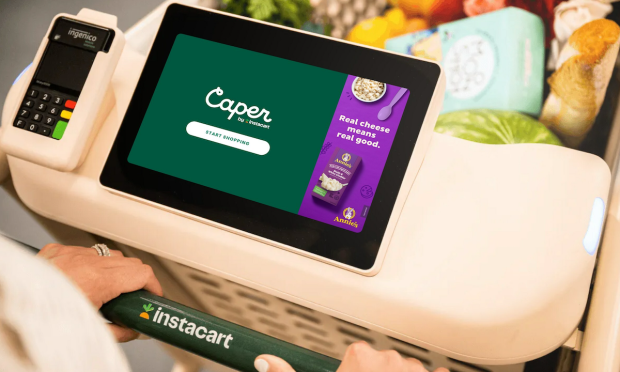
With grocery brands looking for more personalized, targeted ways to reach shoppers, Instacart is enabling in-store digital marketing with smart cart advertising.
The grocery aggregator announced Monday (Jan. 8) that it is pilot testing ads on the screens of its Caper Cart smart shopping carts, enabling real-time targeted messaging, at Bristol Farms stores in Southern California, with more grocers to come. The company said this unlocks advertising opportunities such as recommending Dreyer’s Grand Ice Cream (one of the initial advertisers involved in this pilot) to shoppers who put ice cream cones in their cart.
“Our acquisition of Caper has been a core part of our strategic evolution to support retailers and brands not just online but also in-store,” Fidji Simo, CEO and chair of Instacart, said in a statement. “Today we’re excited to introduce the next phase of this work with a new advertising solution that will further enable thousands of CPG brands to connect with high-intent customers with measurable results — in all the ways people choose to shop.”
Instacart stated in the news release that it plans to have “thousands” of smart carts operating in stores by the year’s end.
The aggregator is not the only grocery technology company targeting these kinds of in-store advertising opportunities. In a June interview with PYMNTS, Guy Mordoch, CEO of A2Z Smart Technologies Corp.’s flagship smart cart product Cust2Mate, said that down the line, the cart will be able to generate “insights that are driven from data,” as well as to run “advertisements and retail media on the cart” based on that data.
Grocers, for their part, are also looking for more in-store digital technologies. For instance, the PYMNTS Intelligence study “Big Retail’s Innovation Mandate: Convenience and Personalization,” created in collaboration with ACI Worldwide, showed that 79% of grocers think consumers would be very or extremely likely to go to a different merchant if not offered access to barcode and QR code scanner apps.
Plus, demand for targeted advertising opportunities is on the rise, as regulations on how companies use consumer data evolve, calling for options that do not involve relying on this kind of information, as Nick Minnick, vice president of strategic partnerships at contextual commerce platform Chicory , told PYMNTS in a conversation in the fall.
“We see increasing interest in some of the solutions that we’ve built,” Minnick said, “where we’re able to target campaigns based off of the content that users are looking at, whether it’s a particular type of recipe or even delivering an ad targeted to a specific ingredient, … to be able to reach shoppers in a cookie-less fashion.”
For Instacart, moves of this kind create the opportunity to drive revenue through higher-margin offerings than the core grocery delivery business, given the high costs of fulfillment. Indeed, across the aggregator industry, key players are finding ways to expand their marketing businesses and drive ad sales to boost profitability, providing sponsored listings on their platforms among other targeted initiatives to secure the spending of consumer packaged goods (CPG) giants.